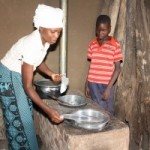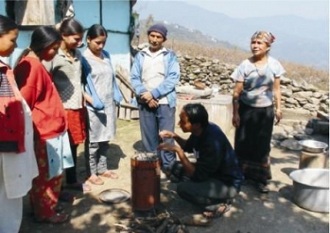Micro-Miniature Indoor Cooking Smoke Exposure Monitoring Device for Children | Source: Azosensors.com | Nov 2, 2012
RTI International has been awarded funding from the Bill & Melinda Gates Foundation to redesign and improve a personal exposure monitor that will be small and light enough to be worn by children and toddlers in developing nations who are exposed to smoke from indoor cooking fires.
The $2 million project has the potential to help scientists better understand the relationship between environmental cookstove contaminant exposures in the air and potential adverse health effects for young children.

Child playing basketball wearing current MicroPEM device. The device will be made smaller and lighter. Jimmy Crawford, RTI International photographer.
“Understanding exposures is critical for protecting human health, but for years scientists and health officials have struggled in their attempts to collect accurate data regarding the exposure of smaller children to smoke from cooking fires,” said Charles Rodes, an RTI senior fellow and primary investigator on the project. “Enhancing our understanding of their exposures will help change how the world cooks.”
To develop the monitor, researchers will build on existing RTI-developed sensing technology called the MicroPEM™ (for micro-miniature personal exposure monitoring), which simultaneously collects integrated and real-time particle data along with its quality control data. It also uses built-in acceleration sensors to determine individual activity levels to gauge when the sensor is being worn.
RTI will partner with researchers from MTL Corporation, who will custom-design a tiny filter, and will work with an advisory panel of experts from Columbia University, The Johns Hopkins University, Imperial College, and the Global Good Fund to help develop and validate the enhanced MicroPEM device. The improvements will foster more accurate characterizations of indoor air pollution in health studies involving children.
As part of the two-year project, the development team will make substantive improvements to the existing MicroPEM technology, reducing its size significantly to tailor it for use by children 2 years old and younger, while also enhancing performance capabilities in smokey indoor environments.
“The existing MicroPEM technology represents a tremendous leap in personal exposure science over prior and existing technologies,” Rodes said. “For the first time, we can simultaneously collect data on the levels and patterns of particle exposure for adults. The critical step now is to take it to the next smaller, less burdensome level that is appropriate for younger children.”
A key feature of the improved optical sensor will be enhanced specificity by adding illuminating laser wavelengths and sensing diodes. These optical enhancements should also provide stronger responses for a wider range of aerosol sizes.
The new design will reduce both the size and weight of the system, making it approximately the size and shape of a smartphone. It will also build on the calibrated output of the on-board accelerometer to innovatively predict children’s breathing rate to better characterize the amount of particulate matter actually reaching into children’s respiratory system.





